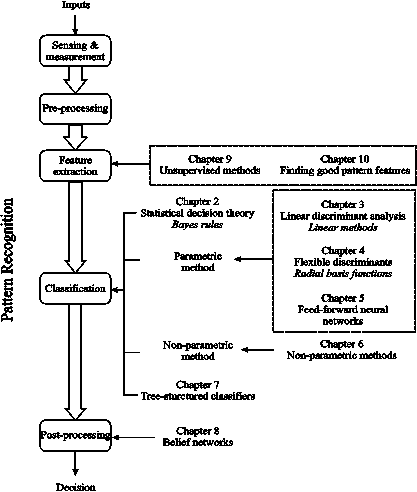|
When I asked Alexandra for the 2nd edition of this book, I did have a copy of first edition borrowed from the NRC�s (National Research Council) library and someone else was on the waiting list. The first version is about 400 pages while the 2nd version is almost the same. Although the tile of this book is Pattern Recognition and Neural Networks, as the author mentioned in the book, neural network is a method used for pattern recognition. Thus, the description of neural networks is naturally merged into the tasks of pattern recognition rather than being written as an independent part of the book. To understand how this book is organized, I prefer to use a chart as shown in Figure 1. On the left side, it is a typical procedure for pattern recognition. The organization of the book can be found from the right side of the figure. This book discusses the methods for feature extraction, classification, and post-processing in a pattern recognition process. Chapter 9 and 10 are devoted to the feature extraction and representation. Other six chapters focus on the classification issue. Chapter 2describes the classification with the Bayes rule, which comes from the statistical decision theory. You may find such a chapter in almost all pattern recognition books just after the introduction. Chapters 3 to 5 are categorized as the parametric method, but they make weaker assumptions that standard parametric models as the author mentioned.� Linear discriminant analysis, flexible discriminants, and feed-forward neural networks are introduced in the three chapters respectively. Chapter 6 contributes to the description of non-parametric methods.� Chapter 7 introduces tree-structured classifiers where the feature space is partitioned into regions and each region is assigned a class. Belief networks are often used as a diagnosis tool to understand the relationships between all the observations. This technique may be used for post-processing. The details are provided in Chapter 8. |


|
BOOKSBOOKSBOOKS
Pattern Recognition and Neural Networks
by B.D. Ripley Whittles Publishing, 2006
Reviewed by Zheng Liu (Canada) |
|
Click above to go to the author�s web page for the book where you will find links to the following:� Description, Contents, Preface, Datasets, Complements, Errata, Search References, Download References, Reviews, Contact author, and Publisher's Web Sites. |


|
The book is well written and organized. It is easy to understand, especially with the examples. Moreover, the datasets are available from the Internet for readers to practice, but there is no software accompanied with this book except a FORTRAN program implementing the k-means clustering algorithm. Nevertheless, this book is still a good reference for graduates in engineering and science as well as those who are new to the pattern recognition field. Without any double, this rigorous work by a professor of statistics can serve as a reference for academic and industrial professionals.� Before jumping to other classic books on pattern recognition or literatures, these four-hundred pages are worth reading and will give you a solid knowledge to comprehend the information on pattern recognition you get from somewhere else. |